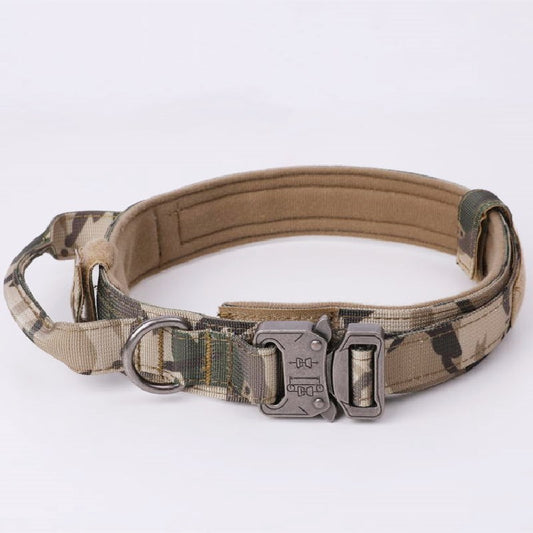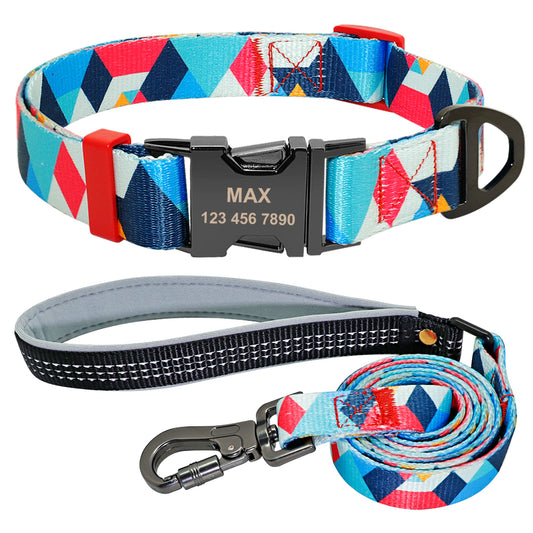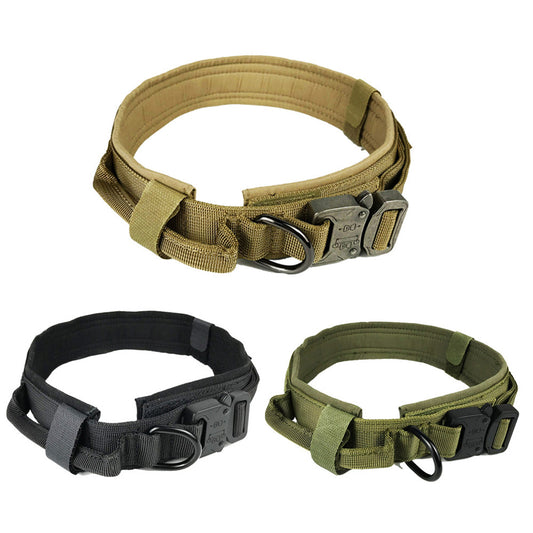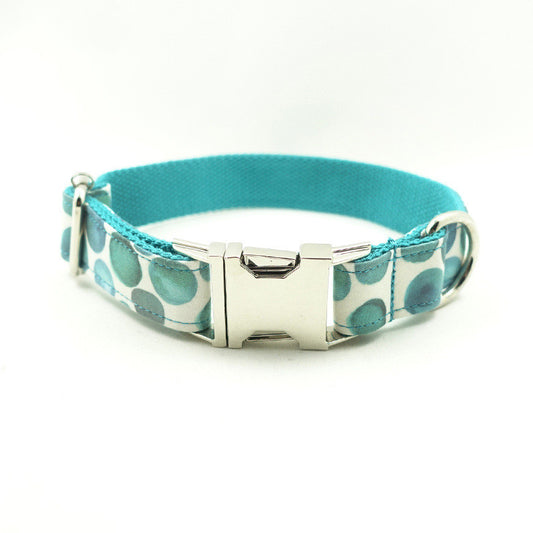The Ultimate Guide About Dog Collars
As a pet parent, you want the best for your furry friend, and choosing the right collar is an essential part of ensuring their safety and comfort. With so many options on the market, it can be overwhelming to decide which one is right for your dog. In this guide, we’ll explore the different types of dog collars available, their features, and how to select the perfect collar for your pooch.
Leather Collars
Leather collars are a classic and durable option for dogs. They are comfortable and flexible, making them an excellent choice for everyday wear. Here are some subheadings and bullet points to consider:
Benefits of Leather Collars:
- Comfortable
- Durable
- Can last for years with proper care
- Softens over time and conforms to the dog's neck
Factors to Consider:
- Cost
- Quality of the leather
- Buckle or snap closure
- Width of the collar
Popular Brands:
- Red Dingo
- Coastal Pet Products
- Soft Touch Collars
Collar Offers
Dog collars come in different styles and offer various features. Here are some of the most popular ones:
-
Reflective Collars: Ideal for night walks or low-light conditions, these collars have reflective strips that make the dog more visible to drivers and pedestrians.
-
Personalized Collars: These collars have ID tags that can be personalized with the dog's name, address, and phone number, ensuring that they can be easily identified if lost.
-
GPS Collars: These collars use GPS technology to track the dog's location, providing real-time updates to the owner's smartphone.
-
Cooling Collars: Perfect for hot summer days, these collars have a cooling gel that keeps the dog's neck cool and comfortable.
Dog Neck
The neck is a sensitive part of a dog's body, and choosing the right collar is essential to ensure your pet's comfort and safety. Here are some subheadings to consider:
-
Measuring Your Dog's Neck: Before buying a collar, it's essential to measure your dog's neck to ensure a proper fit. Use a measuring tape or a string to get an accurate measurement.
-
Proper Fit: The collar should fit snugly around the dog's neck without being too tight or too loose. You should be able to fit two fingers between the collar and the dog's neck.
-
Avoiding Choking Hazards: Collars that are too tight can restrict the dog's breathing, while collars that are too loose can slip off, creating a choking hazard.
-
Signs of Discomfort: Pay attention to your dog's behaviour and body language to determine if the collar is causing discomfort. Signs of discomfort may include scratching at the collar, rubbing their neck against objects, or excessive drooling.
ID Tags
ID tags are an essential part of a dog's collar. They help identify the dog and provide contact information in case they get lost. Here are some subheadings to consider:
-
Information to Include: The ID tag should include the dog's name, owner's name, phone number, and address.
-
Material: Choose a durable material that won't wear out quickly, such as stainless steel or aluminium.
-
Size and Font: The tag should be large enough to read easily, and the font should be clear and legible.
-
Updating Information: If you move or change your phone number, remember to update the information on the tag.
Selecting the Right Collar
Choosing the right collar for your dog can be a daunting task, but it doesn't have to be. Here are some subheadings and bullet points to consider when selecting the right collar:
-
Purpose: Consider the purpose of the collar. Is it for everyday wear, training, or walking?
-
Material: Think about the material of the collar. Is it comfortable and durable? Will it last long?
-
Size: Measure your dog's neck and choose a collar that fits properly. Avoid collars that are too tight or too loose.
-
Closure: Decide whether you prefer a buckle or snap closure. Buckles are more secure but take longer to put on, while snaps are more convenient but may not be as secure.
-
Style: Think about the style of the collar. Do you prefer a simple and classic look, or do you want something more eye-catching?
-
Budget: Consider your budget and choose a collar that meets your needs without breaking the bank.
Flat Collars
Flat collars are the most common type of collar and are suitable for everyday wear. Here are some subheadings and bullet points to consider:
-
Material: Flat collars come in different materials, including nylon, leather, and neoprene.
-
Width: Choose a collar that is wide enough to distribute pressure evenly but not too wide that it interferes with your dog's movement.
-
Closure: Flat collars can have either a buckle or snap closure.
-
D-Ring: The D-ring is where the leash is attached to the collar. Make sure it's strong and secure.
Martingale Collar
Martingale collars are ideal for dogs that tend to pull or slip out of their collars. Here are some subheadings and bullet points to consider:
-
Design: A martingale collar has two loops, one that goes around the dog's neck and another that tightens when the dog pulls or tries to back out of the collar.
-
Material: Martingale collars come in different materials, including nylon, leather, and chain.
-
Size: Measure your dog's neck and choose a collar that fits properly. The collar should be snug but not tight.
-
Training: Martingale collars are commonly used for training, but make sure to use them correctly and with the guidance of a professional trainer.
Leash Attachment
The leash attachment is an essential part of a dog collar. Here are some subheadings to consider:
-
Placement: The attachment can be at the back or front of the collar. The back attachment is the most common and allows for a relaxed walking experience, while the front attachment is ideal for dogs that tend to pull.
-
Material: The attachment can be made of metal or plastic. Metal attachments are more durable and secure.
-
Size: The attachment should be large enough to accommodate the size of the leash clip.
Slip Collar
Slip collars are commonly used for training and walking. Here are some subheadings and bullet points to consider:
-
Design: A slip collar is a loop of chain or nylon that tightens when the leash is pulled.
-
Material: Slip collars can be made of chain or nylon.
-
Training: Slip collars are commonly used for training, but make sure to use them correctly and with the guidance of a professional trainer.
-
Size: Measure your dog's neck and choose a collar that fits properly. The collar should be snug but not tight.
Common Mistakes to Avoid
Here are some common mistakes to avoid when selecting and using a dog collar:
- Choosing the wrong size
- Using a collar that is too tight or too loose
- Using a collar for the wrong purpose
- Not checking the collar regularly for wear and tear
- Not removing the collar during rest or playtime
- Not using a collar with ID tags
- Using a collar as a punishment tool
- Not using the collar correctly during training
Benefits of Using a Dog Collar
Using a dog collar has many benefits for both the dog and the owner. Here are some subheadings and bullet points to consider:
-
Identification: The collar can help identify the dog and provide contact information in case they get lost.
-
Safety: The collar can help control the dog during walks and prevent them from running away or getting into dangerous situations.
-
Training: The collar can be used as a training tool to teach obedience and good behaviour.
-
Bonding: Using a collar during walks and activities can help strengthen the bond between the dog and the owner.
Conclusion
Choosing the right collar for your dog is an important decision that requires careful consideration. By understanding the different types of collars available and their features, you can select the perfect collar for your furry friend. Remember to choose a collar that fits properly, is comfortable and durable, and meets your dog's specific needs.
Frequently Asked Questions
Can I leave a collar on my dog all the time?
Answer: While it's safe to leave a collar on your dog most of the time, it's important to remove it during rest or playtime to prevent accidents or injury.
How do I measure my dog's neck for a collar?
Answer: Use a measuring tape or a string to get an accurate measurement of your dog's neck. Make sure to measure at the widest part of the neck and add two fingers' space between the collar and the dog's neck.
Can I use a collar for training my dog?
Answer: Yes, collars can be used as a training tool, but it's important to use them correctly and with the guidance of a professional trainer.
How often should I check my dog's collar for wear and tear?
Answer: You should check your dog's collar regularly for wear and tear, especially if it's made of materials that can deteriorate over time, such as nylon.
What type of collar is best for a small dog?
Answer: Small dogs can benefit from a flat collar or a martingale collar, depending on their specific needs and behavior. It's important to choose a collar that fits properly and is comfortable for your furry friend.





